HOT SHOT 12, 13-IMPROVE YOUR SKETCHING BY SQUINTING AND SEEING SHAPES
This is a double hot shot and I have decided to combine them both because they are related!
It’s all about having your eyes partially closed in order to see the main shapes in whatever you plan to sketch and then using this to quickly get down some basic marks to get going while sketching this is very helpful when approaching complicated subjects.
But before we continue If you missed my last Hot Shot, number 11, on actually sketching what you see and not what you know about what you see. Click HERE
This video is only relevant from 0.19secs to 0.47secs where I actually used this tip to approach this scene while doing a quick oil sketch during my Bath Marathon of paintings in 2010.
You’ll notice me closing my eyes and sketching. I do this just to see the relevant shapes and I put those down very quickly before continuing with the process.
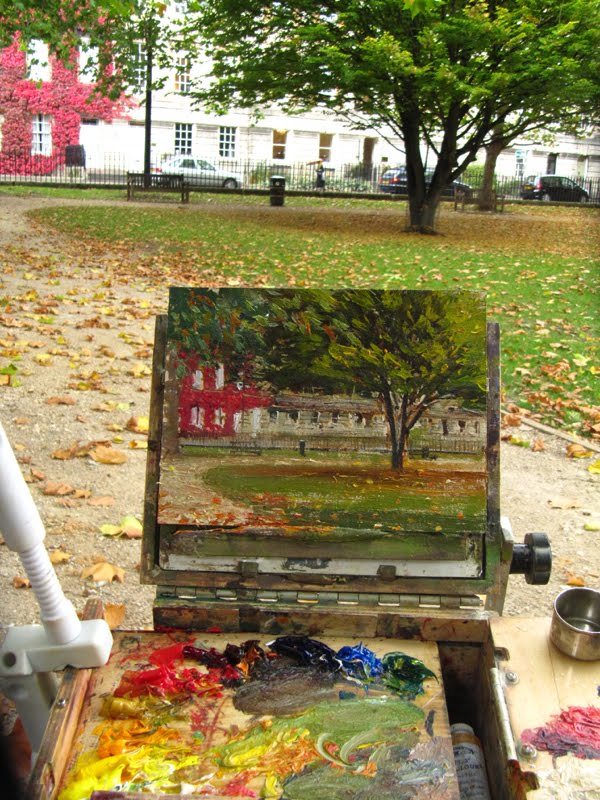
The scene from the video and the oil sketch on the Easel-Here you can see a clearer view of how the scene has been broken down into simple shapes. It all started from the squinting while sketching at the beginning and the squinting continues while taking on different parts of the scene, especially the tree.
HOT SHOT 12,13
12. Always remember that you want a simpler way to sketch what is in front of you. This is only possible by squinting. With your eyes half open or looking only with your strongest seeing eye, you should always squint to distill all the unnecessary detail into basic shapes.
13. Shape or shapes is a big word in the sketch inspiration. Breaking things down into shapes can be a highly effective way of sketching- this is a very useful when sketching complicated subjects.
An example of how this helps can be seen in the way I approached this complicated scene of a street in San Fransisco, I worked from a very complicated photograph. But the same rule applies.
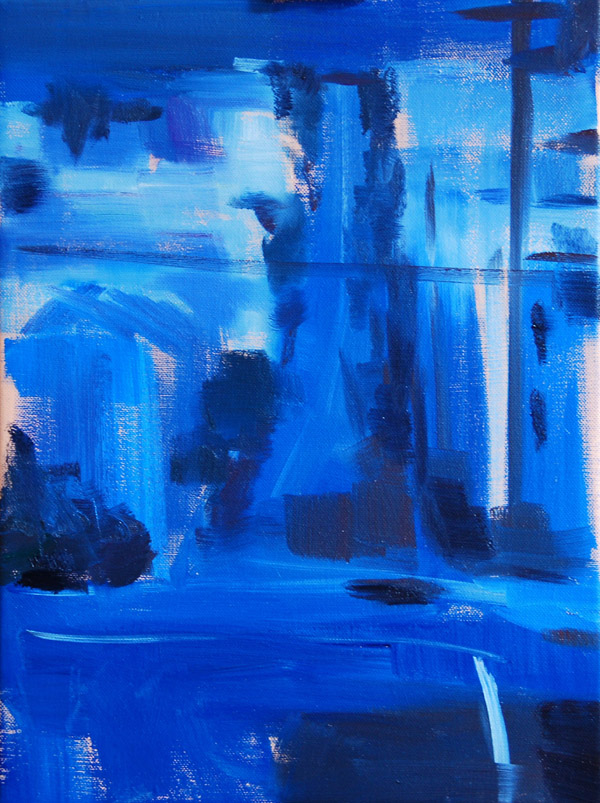
San Fransisco Blues- THE EFFECT OF SQUINTING to SEE the MAJOR SHAPES- You can see how squinting helps in approaching a very complicated scene. It helps to bring all the shapes and values down so that only the important is emphasized at this stage.
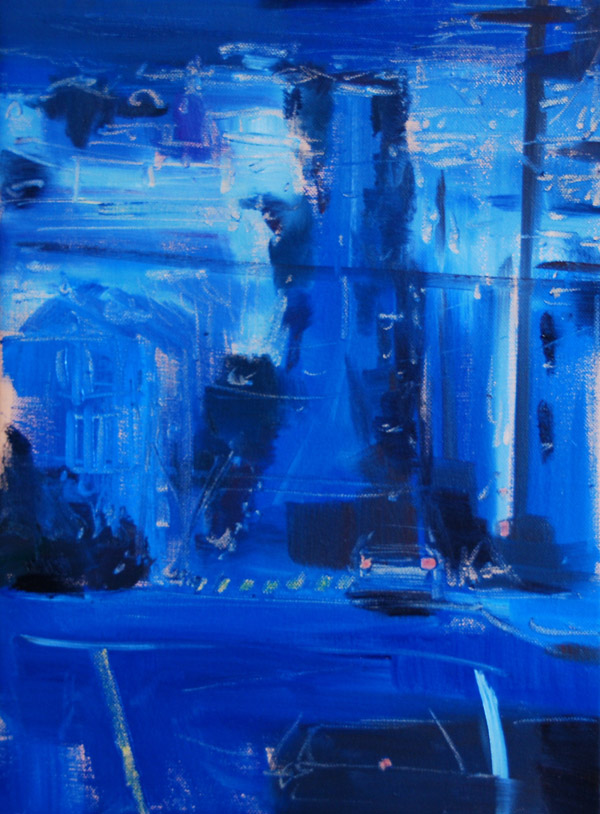
San Francisco blues- the second stage- Here you can see how the first stage of squinting has helped me to start adding details little by little-It's like creeping into the scene quietly then making a lot of noise at the end!
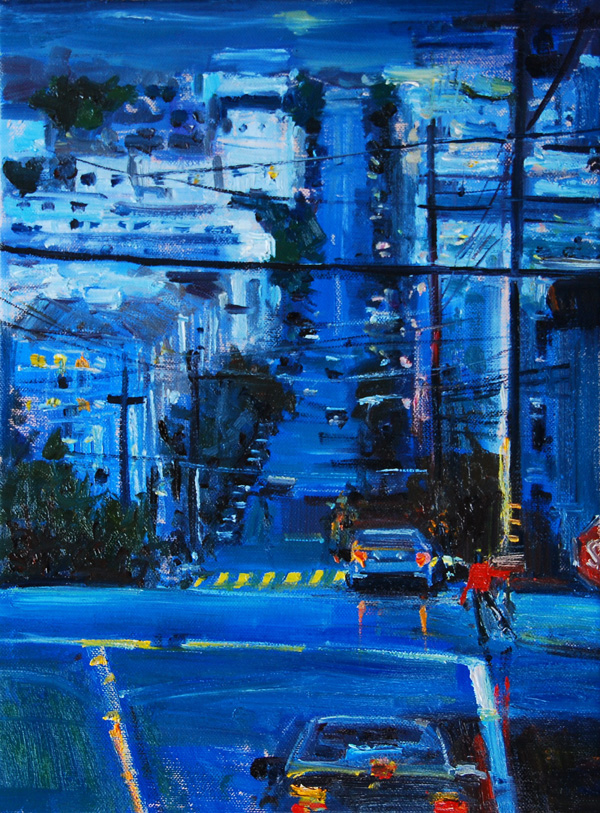
San Francisco Blues- the completed scene- everything is complete here, but it all started from distilling everything down to simple shapes by squinting to get the initial stage up and running
For me, this hot shot is one of the great secrets of sketching and painting in general. It really helps in sketching- I have developed a constant habit of squinting to see everything around me and even when I am not sketching I often ask myself, “How would I be able to knock that out into simpler shapes ?” or “How would I be able to reduce those tones just down to three?”
The habit of constantly questioning is powerful! It’s the rule of simplification! Always say something like,“I can make this subject I am about to sketch simpler!” It’s about editing out the unnecessary and focusing on the bigger picture when starting off.
When sketching on public transport, If I notice a figure and I really want to sketch fast but still have a degree of accuracy about what I am doing, I use my Tom Bow Dual Felt pen to quickly put down the main shapes. If I was using a pencil, I’ll use broad strokes or chunky graphite to get the broad shapes in first.
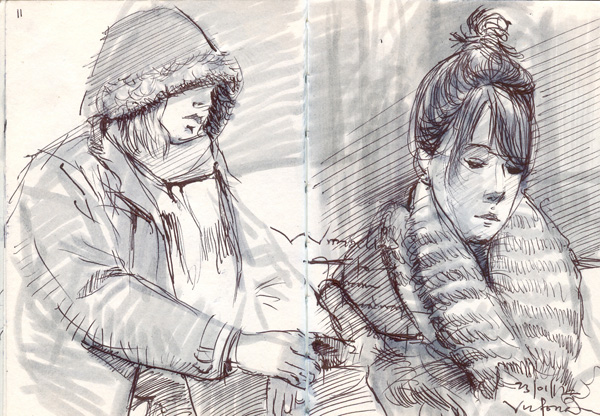
Sketches of two sleeping ladies on Public Transport- The overall shapes with the wash pen were put in first then I added the lines. It's just another way of approaching whatever you plan to sketch.
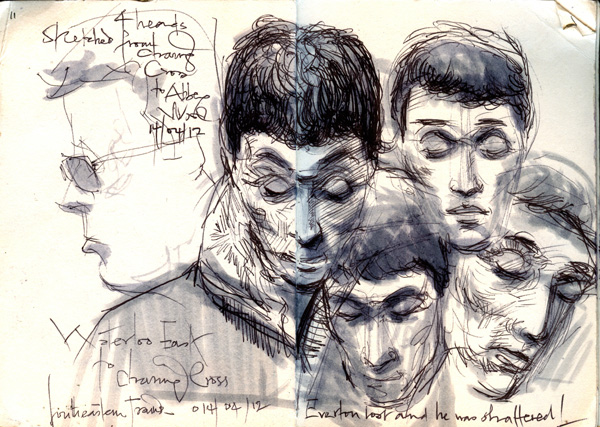
Sketches of a guys face on Public Transport- Here It would have been hard to capture the moving head of this guy. I worked on all four heads at a time putting in the basic wash shapes of each position he took while sleeping, then I filled in the lines where necessary.
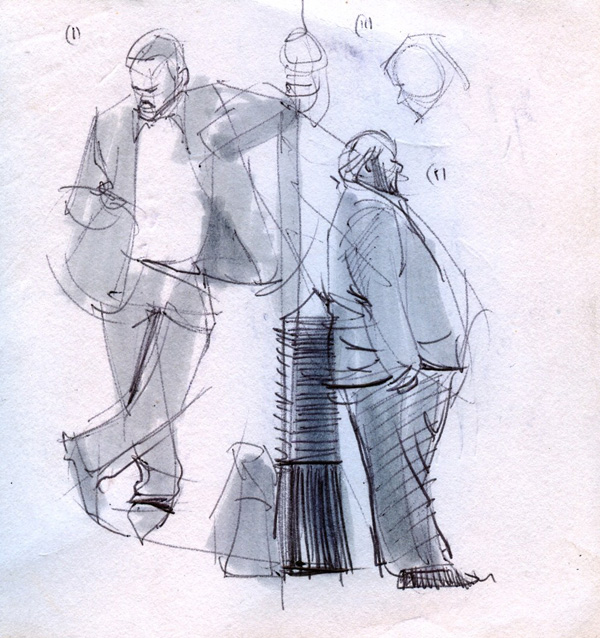
Sketches at the Bus Stop- The first thing I did was to block in the basic shapes with the Tom Bow wash pens then I added the lines. You can easily see those shapes and how they stand as a solid base for the rest of the line work.
Here below is another example of how squinting helps to start off a piece I did of a Berimbau player.
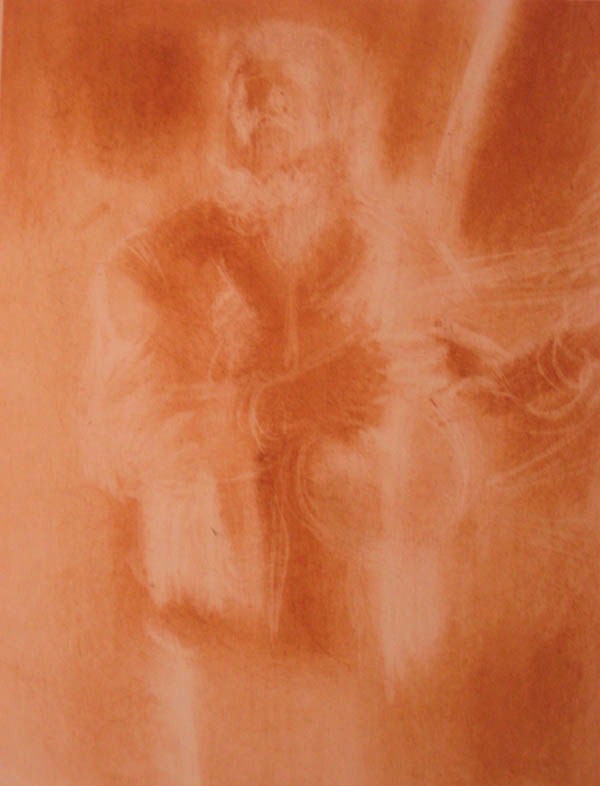
Berimbau player-STAGE 1- With Squinting I am able to edit the details and focus on the larger main shapes- I used Sanguine dust with tissue to block in the shapes. I used a putty rubber to pick out the highlights.
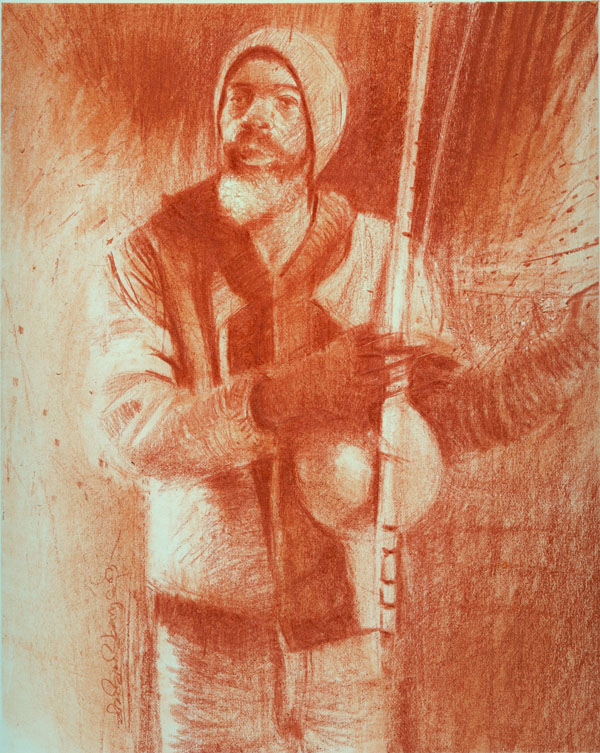
Berimbau Player- Final Stage- Everything is in place but always compare this with the beginning, the shapes at the first stage, give it a firm foundation.
And finally another video where I demonstrate very briefly what I have been talking about.
In the demo I Joshua, my son is the model
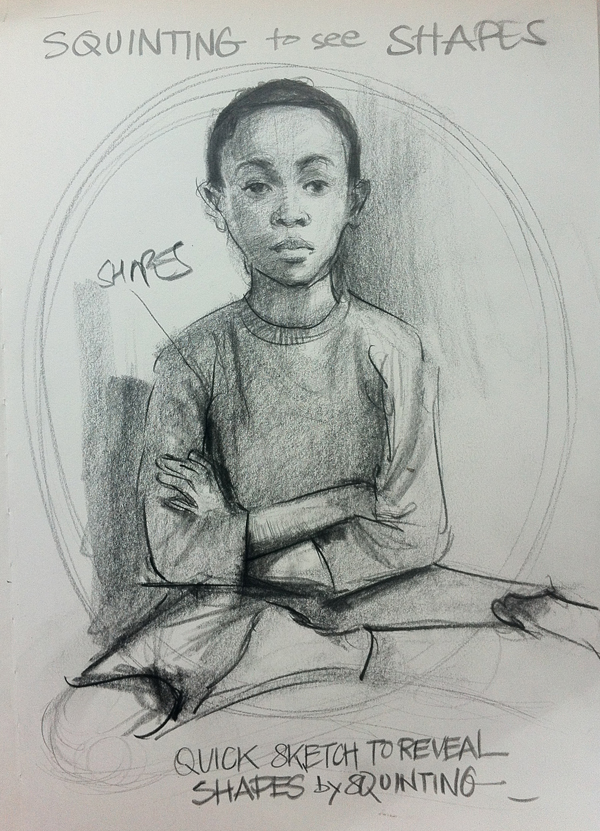
The Demo-Squinting to see the shapes-JOSH- this is a very "brief" demo which I completed later on. It was to show how squinting distills the details and helps focus on shapes. I started with chunky graphite and ended up with lines with an oil base pencil
I hope you picked up something from this post. Squinting is very powerful. Whenever I get into sketching or painting something and it seems difficult, I remind myself to SQUINT! Once I squint it helps my me sketch or paint “without my brain”.
Please comment, share or like with the social media buttons below and let the inspiration flow!!!!
Tagged with: Adebanji Alade • alla prima • ball point pen • bic ball point pen • graphite • plein air • Public Transport • shapes • sketching tips • squinting • tombow dual brush pens • urban sketching
Filed under: Inspiration to sketch • Sketching Tips
Like this post? Subscribe to my RSS feed and get loads more!
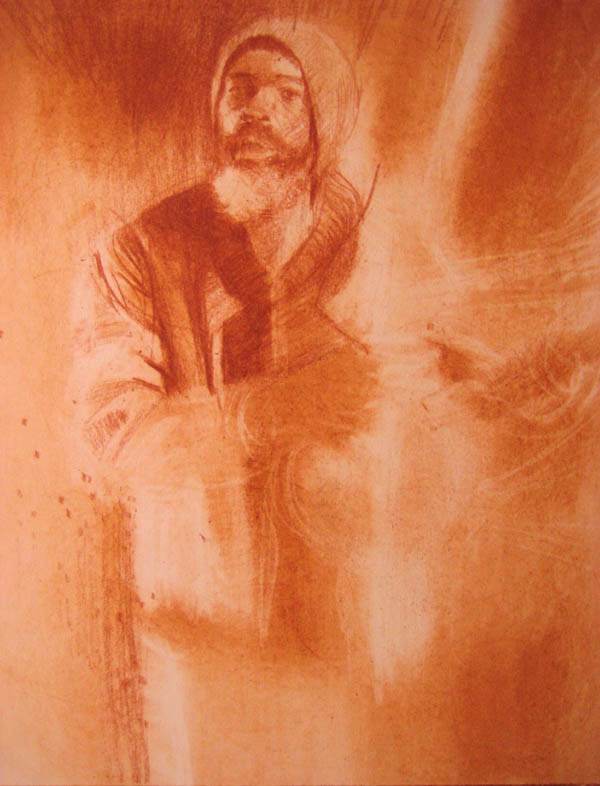

Excellent – its worth noting also that progressively squinting can help to sort out whether edges are hard, soft, or lost.
Incidentally – the sanguine wipeout of the Berimbau player is terrific!
Thanks Ever so much Dave for highlighting the point on Edges! I completely forgot to mention this too. It would have to be something I ‘ll build on in a future post.
But for those of us that may not understand what edges mean. They are places where two forms or planes meet.
When one Squints one is able to see edges more clearly too!
According to Morgan Weistling an Artist I have learned so much from, he says there are four edges namely: Hard, Soft, Firm and Lost. I’ll be elaborating on this in a future post for sure.
Thanks once again for highlighting this Dave!
Ha! You’ve told us to look very carefully and also to close an eye or squint so we can barely see. I understand what you mean since you make it all very clear. But it just sounds funny. Next, you’ll be telling us to stand on our heads or close both eyes! Thanks you very much for your kind and informative posts, Adebanji.
Lol!!! Oh my days!!! Jon you almost made me fall over my seat with laughter!!!
OK, no more HOT SHOTS-Just sketch!!! lol!!
Thanks for the positive feedback!!
I am finding this all very useful. I like the dark oil based pencil you use … I have never come across one … Keep up the good work.
Thanks Bill! I really love the Oil Base pencil, once I discovered it, I hardly used the charcoal pencils again.
Very useful advice and I too love the Berimbau player; a technique I shall have to try. My suggestion instead of squinting (which I do do), is to wear my reading glasses to look at a distant view. That way I can still see what I’m drawing but the model blurs and I see only shapes
Diana, thanks, I think that would work too! There are so many techniques but this is the one I use when the subject is a bit complicated. It’s just a very good way to start!
Thank you very much for this great post. I knew about basic shapes and squinting before (in the first place when it comes to tonal values), but I’ve never seen such a detailed explanation of how to work with it and which techniques can be used.
Another eye-opener!
Thanks Anne, I’m glad you’ve gained something new!
Thank you for your time and dedication to share your inspirations with us. You are truely a blessing. Thank you to your family as well, who obviously support your work.
Oh Denise you are most welcome! They do support me- my wife does the recording, while Josh does the modelling, while Kezia is learning how to keep quiet while the recording is going on!
Hello again,
Thank you for this valuable lesson – I know I personally find it hard to start with the main shapes and tones, as I want to get straight on with the details! Another thing that is helpful when you just sketch the basic shapes, is that you see the whole compostion on the page rather than starting with a little bit of detail and then finding you can’t fit the whole subject on the page!
Thanks again for your inspiration and for your very professional model…. I look forward to the next one.
Thanks Sarah! You are right about it helping to see the whole composition on the page rather than starting with with little details.
The little detail trap is always a tempting one to fall into but with this in mind it’s easier to overcome! We love to start around an area that interests us, which isn’t wrong but where it becomes a problem is when we spend too much time on it and not branch out to other areas.
Excellent Hot Shot Adebanji. Thank you for the time and effort you put into these lessons! I will be squinting to see basic shapes!
You are welcome Joel! I’m glad you’ll be doing this!
Great work, love your drawing and painting styles. I would like to start doing oil sketches but I’ve never done oils before. Do you know any oil painting courses around the London area?
Thanks Carlos! You can find out from http://www.heatherleys.org/- they have some good tutors and that’s where I studied.
I also teach privately, if you are interested let me know too.
Thank you very much for the detailed explanation Adebanji. I have gone through most of your videos and must say they are fantastic and very helpful. I have personally tried Squinting and the results were mind blowing. There are a few more things that I am facing problem with, like portraying the edges of a building and getting the proportions of human figure. Please let us know if you’ve got some tutorials on that as well 🙂
Thanks Raghu! I’m glad you are enjoying and benefiting from these lessons!
I don’t exactly understand what you mean by edges of buildings.
But when it comes to proportions of the human figure- that has come up before in one of my hotshots- proportion in a less technical way will improve with practice. But for technical ways- measuring is the way!
There’s not much time to measure when sketching but it’s worth doing, when we want things to look right.
I’ll treat the measuring aspect in latter posts.
So with respect to the teaching on outline; do You outline then after You get in the shapes, but prior to tone and other details? Thanks.
Hi Ed, I read this question over and over again but I didn’t quite get what you mean…I wish you can clarify it a bit more. Thanks
Hi adabanji
I got really inspired when I first had a look at your website…your work is too impressive and I love it…u have a brilliant talent and the perfect body language as an artist..I also wanna be an artist ..advice and guide us all